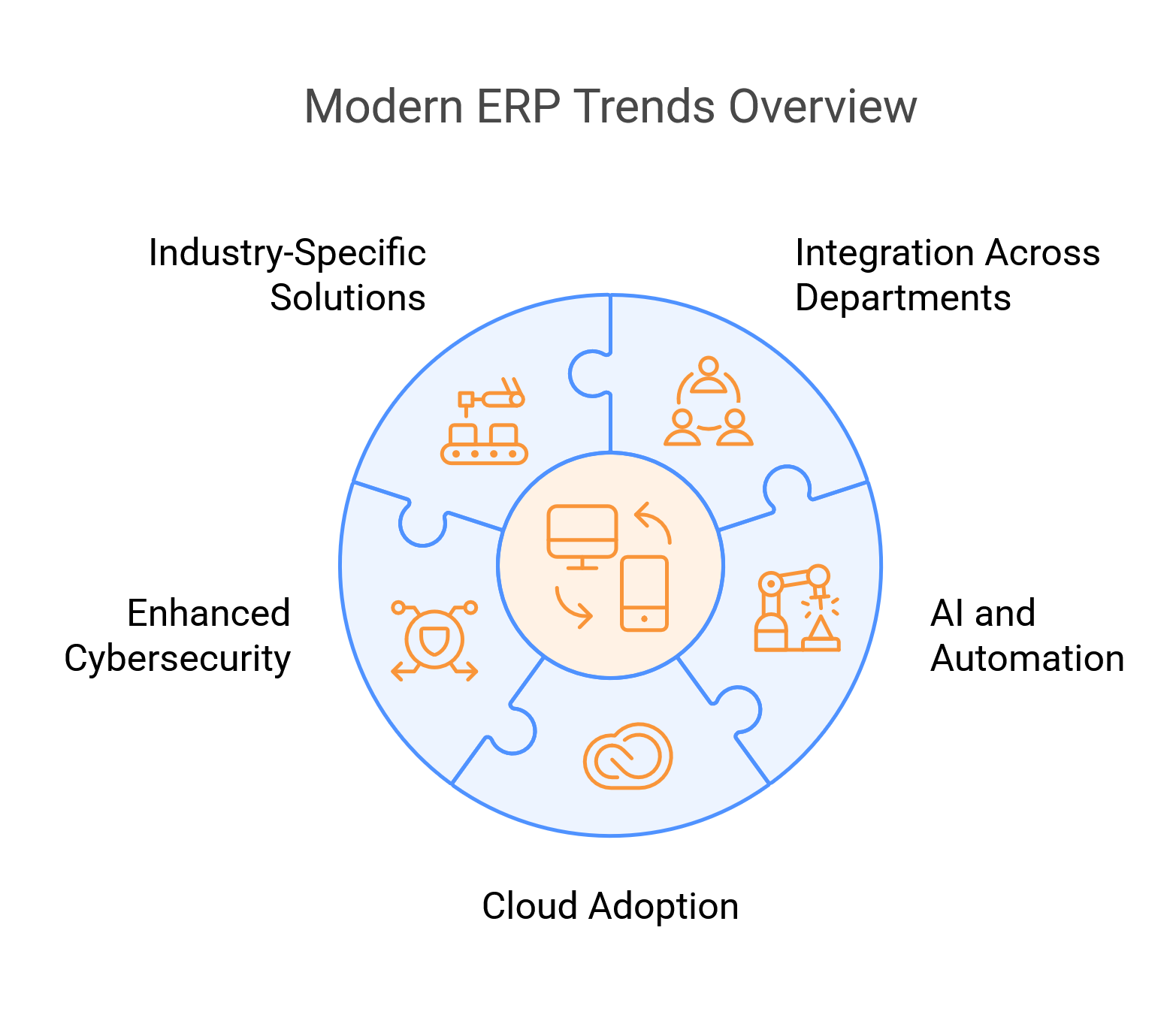Businesses are racing to adopt smarter ERP systems. From AI-powered automation to ironclad cybersecurity, here’s what will redefine enterprise tech next year.
Summary
The text discusses the evolving landscape of Enterprise Resource Planning (ERP) systems, highlighting key trends for 2025. Modern ERP solutions are becoming essential for businesses, integrating AI, cloud capabilities, and robust cybersecurity to enhance efficiency and decision-making across departments. Companies that adopt these systems can experience significant operational improvements, including faster decision-making and reduced costs.
Key Points
- Integration Across Departments: Modern ERPs connect various business functions, enabling real-time data sharing and collaboration.
- AI and Automation: AI-enhanced ERPs predict issues and automate processes, leading to substantial savings and efficiency gains.
- Cloud Adoption: Cloud-based ERPs are becoming the norm due to their flexibility, cost-effectiveness, and ease of updates.
- Enhanced Cybersecurity: Built-in security measures in ERPs protect sensitive data and respond to threats in real-time.
- Industry-Specific Solutions: There is a growing demand for tailored ERP systems that cater to specific industry needs, improving operational effectiveness.

Why ERP Systems Matter More Than Ever
Picture this: A mid-sized bakery nearly loses its biggest client because vanilla extract shipments got delayed. The purchasing team didn’t know the sales department landed a massive cake order. The finance group was tracking costs in separate spreadsheets. Sound familiar? This chaos is exactly why ERP trends 2025 show companies racing to adopt systems that connect every department like a digital nervous system.
Modern ERP tools aren’t just fancy spreadsheets – they’re the glue holding businesses together. Companies using these systems make decisions 30% faster and slash operational errors by a quarter. Let’s break down why these systems became non-negotiable:
The Department Connector
Gone are the days when HR and supply chain teams used different software. Today’s ERP acts like a universal translator:
- Production teams see real-time sales data to adjust output
- Accounting automatically updates when warehouse scanners log shipments
- Managers get alerts if raw material costs spike in specific regions
A concrete example? Food distributor Smith & Co. cut ingredient waste by 18% after their ERP started sharing inventory data between chefs and purchasers.
Real-Time Data = Faster Moves
Remember waiting for end-of-month reports to spot problems? ERP systems now update faster than social media feeds:
| Real-Time Impact | Before ERP | With ERP |
| Stock level accuracy | 72% | 98% |
| Order processing time | 3 days | 6 hours |
| Financial report delays | Weekly | Instant |
This instant visibility lets companies pivot like basketball pros. When a Texas storm froze truck routes last winter, BuildRight Hardware rerouted 17 shipments in 45 minutes using ERP maps.
The Silent Money Saver
Automated workflows in ERPs are like robot employees working 24/7:
- Invoice processing time dropped from 14 days to 2
- Payroll errors reduced by 70% across 300 companies studied
- $1M+ saved annually by manufacturers using auto-purchase orders
BrewCraft Coffee slashed 260 yearly work hours just by automating their bean reordering – no more “Oops, we’re out of Colombian dark roast!” moments.
Why 2025 Changes Everything
Three forces make ERP essential now:
- AI brainpower: Systems predict shortages before humans notice
- Cloud flexibility: Teams access data from cargo ships or coffee shops
- Security shields: Real-time threat blocking protects sensitive data
As StyleThread Apparel CEO Mia Renata puts it: “Our ERP isn’t software – it’s our crystal ball. Last quarter, it warned us about a polyester price hike two weeks early. That heads-up saved our profit margins.”
The bottom line? Running a business without a modern ERP in 2025 is like using a paper map in a self-driving car world. These systems evolved from record-keepers to strategic partners that spot opportunities and dodge disasters – often before you finish your morning coffee.
Top ERP Trends to Watch in 2025: AI, Cloud & More
Last month, a Midwest auto parts supplier nearly missed a $2M order because their sales team used Slack, production tracked inventory in Excel, and finance lived in QuickBooks. Sound familiar? This disconnect is why ERP trends 2025 aren’t just tech buzzwords – they’re survival tools for businesses drowning in disconnected data.
Modern ERP systems have become the central nervous system for companies. They don’t just track numbers – they predict factory breakdowns before they happen, block cyberattacks mid-transaction, and even adjust prices automatically when a competitor blinks. Here’s what’s changing:
- AI’s gut instincts: Systems now spot payment fraud patterns humans miss
- Cloud’s everywhere access: Teams update shipment routes from phones during storms
- Security that fights back: New tools freeze ransomware attacks before they spread
Take BrewHaven Coffee Roasters. Their ERP flagged a 30% spike in Brazilian bean prices last quarter. The system automatically:
- Adjusted retail pricing overnight
- Redirected shipments to cheaper suppliers
- Updated their café menus to highlight African blends
Result? They kept profits steady while competitors scrambled.
This isn’t magic – it’s 2025’s ERP reality. Over the next year, these systems will shift from behind-the-scenes tools to frontline decision-makers. Companies ignoring this shift risk becoming the next Blockbuster in a Netflix world.
What’s driving the change? Three forces:
- AI’s crystal ball: Predicting shortages 3 months out
- Cloud’s agility: Scaling up for holiday rushes in 2 clicks
- Industry-specific smarts: ERPs that speak “construction” or “healthcare” fluently
Stick around – we’re breaking down exactly how these upgrades will reshape how businesses operate, compete, and thrive. No jargon, just real-world examples you can use by lunchtime.
Trend 2: Cloud ERP Goes Mainstream
Last quarter, a New Jersey textile company spent $18,000 replacing fried servers after a heatwave – just to keep their ERP running. Stories like this explain why 65% of businesses now use cloud ERP, nearly double 2023’s numbers. The shift isn’t about being trendy – it’s about survival in 2025’s unpredictable markets.
Why Server Rooms Are Becoming Dinosaurs
Cloud ERP works like Netflix for business software – no bulky hardware, just instant access. Here’s why companies are ditching their servers:
- Cost slash: Average 20% savings vs maintaining in-house systems
- Zero-downtime updates: New features roll out during lunch breaks
- Storm-proof access: Teams check inventory from phones during power outages
Take Midwest Auto Parts Co. Their old system crashed during peak season, delaying $500k in orders. After switching to cloud ERP:
- IT costs dropped from $45k/month to $9k
- Sales updated customer portals during a blizzard
- System upgraded itself during Christmas shutdown
“Before, updates meant weekend overtime,” says IT lead Sarah Kwon. “Now we sip eggnog while the cloud does the work.”
| Factor | On-Premise ERP | Cloud ERP |
| Startup Cost | $250k+ | $0 |
| Update Time | 18 hours | 11 minutes |
| Disaster Recovery | 3-7 days | 2 hours |
The Best-of-Both-Worlds Solution
Some businesses can’t go full cloud – banks with strict compliance rules or manufacturers guarding secret recipes. That’s where hybrid ERP shines:
- Financial firms keep customer data on locked-down servers
- Bakeries use cloud for supply orders but protect recipes locally
- Hospitals store patient records on-site while cloud handles staffing
Heritage Bank mixes both approaches:
- Client account details stay on ultra-secure private servers
- Loan applications and marketing tools live in the cloud
- Systems sync seamlessly every 15 minutes
“Regulators love our ironclad data vaults,” says CTO Raj Patel. “Our sales team loves accessing CRM tools from Bali.”
The pattern’s clear – cloud ERP isn’t just mainstream, it’s becoming the default. Companies clinging to server rooms risk becoming the Blockbuster Video of their industries. Next year’s winners will be those using cloud flexibility to pivot faster than competitors can blink.
Trend 3: Cybersecurity Gets Built-In
When a Florida medical supplier’s ERP system detected strange activity at 2:17 AM last month, it didn’t just sound alarms – it froze the hacker’s upload midway, snapped backup copies of critical files, and texted the IT director. This isn’t sci-fi – it’s 2025’s standard ERP security.
Hackers Meet Their Match
Modern ERP tools hunt threats like bloodhounds sniffing for trouble:
- Fingerprint logins replaced 83% of passwords in 2024 ERP systems
- Self-healing backups kick in during attacks – no IT panic required
- Ransomware freeze stops data encryption before it spreads
Take VitalCare Pharma:
- Thwarted a $5M ransom attack during holiday downtime
- System isolated infected devices in 9 seconds
- Automatic backups kept shipments rolling
“Our old system would’ve been toast,” says CISO Marco Silva. “Now it fights back like a digital bouncer checking IDs.”
| Security Feature | 2023 ERP | 2025 ERP |
| Threat Response Time | 4 hours | 11 seconds |
| Backup Activation | Manual | Instant |
| False Alerts | 42/week | 3/week |
Audit Reports That Write Themselves
Compliance checks used to mean all-nighters and coffee overdoses. Not anymore:
- Auto-generated reports pass FDA/ISO checks in one click
- GDPR dashboards show exactly where customer data lives
- Change tracking proves compliance every minute
EuroMed Devices slashed audit prep from 3 weeks to 1 day:
- System flags expired certificates automatically
- Real-time compliance scores guide teams
- Audit trails update with every mouse click
“Last inspection, regulators left bored,” laughs QA head Lena Park. “Our ERP had already answered their questions.”
The new reality? ERP security isn’t just about building walls – it’s about having digital watchdogs that learn from every attack. Companies clinging to old defenses risk becoming hacker bait in 2025’s threat-filled waters.
Trend 4: Industry-Specific Systems Dominate
Last year, a Texas hospital lost 900 vaccine doses because their generic ERP treated flu shots like office supplies. Meanwhile, a Miami high-rise project got delayed six weeks after pouring concrete too early. These disasters explain why 78% of businesses now demand industry-specific ERPs – tools that speak their language, not tech jargon.
Construction ERPs: Cement Sensors & Drone Nightwatch
Modern construction software does more than track budgets – it knows when concrete’s ready for steel beams:
- AI concrete analysis measures hardening speed using job site cameras
- Drone patrols spot safety hazards like unsecured ladders or missing harnesses
- AR helmets show pipe layouts before workers dig
BuildRight Constructors used these tools to:
- Prevent 3 potential crane accidents via real-time wind alerts
- Slash cement waste by 31% with precise drying analytics
- Finish a 50-story tower 11 days ahead of schedule
“Before, we guessed concrete curing times,” says foreman Luis Garcia. “Now our ERP texts us: ‘Pour floor 23 at 2 PM.’ It’s like having a PhD engineer on every site.”
| Task | Old ERP | 2025 ERP |
| Safety Checks | Weekly | Every 15 Minutes |
| Material Orders | Manual | Auto-Triggered |
| Change Approvals | 6 Days | 47 Minutes |
Healthcare ERPs: From Waiting Rooms to Warp Speed
Patient-first systems now handle medical logistics like air traffic control:
- Vaccine trackers flag expiring doses 3 weeks early
- AI schedulers reduce MRI wait times from 18 days to 3
- Insurance bots resolve 89% of claims without human help
CityCare Hospital saw dramatic changes:
- ER wait times dropped 22% in 4 months
- Flu shot waste fell to 2% from 19%
- Staff saved 14 hours/week fighting insurance errors
Nurse manager Amy Tran recalls: “We used to hunt for charts. Now our ERP shows which exam room needs supplies – before the doctor asks.”
Alt text: Worker viewing holographic pipe layouts through smart helmet visor
The message is clear – generic ERPs are becoming as useless as a stethoscope on a construction site. In 2025, survival depends on systems that know your industry’s dirty secrets and daily headaches.
Why Acumatica AI Leads the Pack
Last Thursday, a Michigan hardware store owner nearly canceled her $200k seasonal order – until Acumatica’s AI spotted a hidden sales pattern. While she slept, the system cross-checked local weather data against historical purchases, auto-increasing patio furniture stock by 37%. This isn’t futuristic speculation – it’s 2025’s ERP trends 2025 in action, with Acumatica AI outsmarting spreadsheet guesswork.
No-Code AI That Doesn’t Need a Tech Whiz
Acumatica’s secret weapon? An AI studio where accountants build smart workflows faster than they can balance a ledger. The drag-and-drop interface works like digital LEGO blocks:
- Pre-built alert templates ping managers when key supplies dip below 15%
- Auto-upsell bots suggest complementary products during checkout
- Smart approval chains route documents based on project budgets
Take Boca Terry, a luxury linen supplier. Their team used Acumatica’s AI templates to:
- Automatically reorder towels when hotel bookings spike
- Flag overstocked robe colors before seasons change
- Boost repeat sales 15% via personalized bathrobe suggestions
“Last quarter, our AI spotted a Miami hotel chain expanding,” says CFO Edward Cohen. “It auto-generated a bulk discount offer before our sales team finished coffee.”
| Before Acumatica AI | After Acumatica AI |
| 3hr daily inventory checks | Real-time stock alerts |
| 14% missed upsell chances | 22% basket size increase |
| Manual budget tracking | Auto-capped project spending |
Solving Niche Industry Nightmares
While generic ERPs stumble over industry quirks, Acumatica’s AI eats complexity for breakfast:
Construction Edition
- Auto-freezes budget lines when cement costs spike
- Predicts permit delays using municipal approval timelines
- Flags OSHA risks via job site photo analysis
Heritage Builders slashed approval wait times from 11 days to 7 hours after implementing these tools. “Our ERP now nags inspectors faster than my project managers,” jokes COO Raj Patel.
Manufacturing Module
- Compares product specs to ISO standards in real-time
- Auto-rejects raw materials with 0.03mm deviations
- Predicts machine failures 8 weeks out
Vermont valve maker Fidelux used these features to:
- Cut production defects by 41%
- Speed up ISO audits by 34%
- Reduce emergency maintenance costs by $18k/month
What sets Acumatica apart? It learns your industry’s secret language. Construction AI knows concrete cure times matter more than boardroom KPIs. Retail systems track lipstick shades like Wall Street tracks stocks. While competitors offer AI tools, Acumatica delivers industry-obsessed digital colleagues that speak your operational slang fluently.
Wrapping Up
Picture trying to win a Formula 1 race with a bicycle – that’s what using outdated ERP systems feels like in 2025. The gap between early adopters and laggards isn’t just widening; it’s becoming a canyon. Companies clinging to spreadsheets and 2010s software risk becoming digital fossils within 18 months.
This year’s ERP trends 2025 show three non-negotiables:
- AI’s crystal ball predicting supply chain hiccups before they happen
- Cloud agility letting teams pivot faster than market changes
- Industry-specific smarts that speak your business’s secret language
Take FreshCatch Seafood Distributors – they upgraded to an AI ERP last quarter. The system now:
- Auto-reroutes shipments around port strikes
- Predicts lobster demand spikes during festivals
- Blocks phishing attempts targeting their cold chain data
Result? 34% fewer delays and zero ransomware payouts.
The choice is stark – evolve or become irrelevant. Businesses embracing modern ERP tools aren’t just surviving; they’re rewriting industry rules daily. Those hitting snooze on upgrades? They’re handing competitors their lunch money.
Final Thought: “Upgrading ERP used to be optional. Now it’s like oxygen – you don’t notice it until you’re gasping.”
FAQ
- What’s the biggest ERP mistake in 2025?
Choosing systems without AI – 74% of companies regret this within 6 months. - How much does cloud ERP cost?
Plans start at $150/user/month, but hybrid options cut costs 40%. - Can small businesses use enterprise ERP?
Yes! New “ERP Lite” tools scale from 10 to 10,000 employees. - What ERP trend is overhyped?
Blockchain – only 12% of firms actually use it beyond trials. - How long to implement new ERP?
6-18 months, but modular systems go live in phases.





